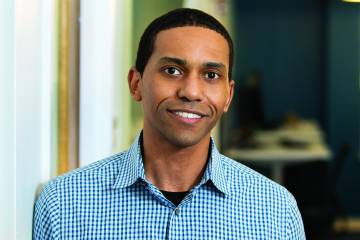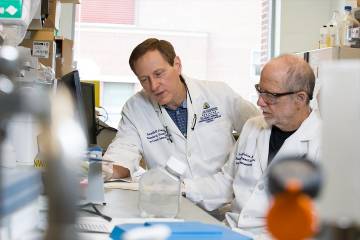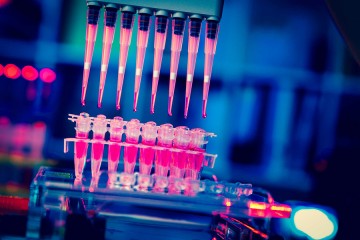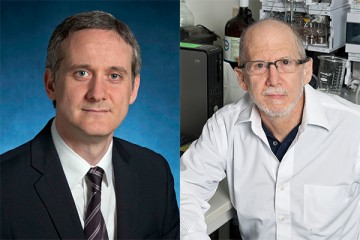It seems odd to hear Bert Vogelstein talk about failure.
He is, after all, widely recognized as a resolute pioneer of cancer research, and is co-director, with Ken Kinzler, of the Ludwig Center at the Johns Hopkins Kimmel Cancer Center, a laboratory that has remained at the field's forefront for more than three decades.
Well before the development of today's gene-sequencing technology, Vogelstein led a research effort determining that human cancer grows through a series of genetic mutations. He then produced a model for the sequence of genetic mutations that occur as a tumor expands—a schematic that became known as a Vogelgram. With more than 374,000 citations and counting, he is among the most highly cited scholars of all time.
But, as he points out, all the lab's achievements and groundbreaking advances have flowed from taking risks and accepting the many failed experiments and mistaken hypotheses that come with that. For Vogelstein, the not-afraid-to-fail approach is one of the more critical lessons he and Kinzler have passed on to the scores of young scientists who have trained with them over the years.
"Tolerating failure is not simple," he says, leaning forward at his desk during a Zoom call. "It's especially challenging for people who have succeeded their whole lives. They've never gotten less than an A. The hard part—and this is something all graduate students face, that I faced—is that you're going to fail. This is not unexpected. It's routine."
That message, however, has a flip side.
"If you're going to go into research," he says, "you want to set the world on fire. If it's not likely to fail, you're not thinking big enough."
The credo of thinking big and pushing science forward despite inevitable setbacks has carried Vogelstein, Kinzler, and their lab through a remarkable flow of accomplishments.
Back in the 1980s, when cancer couldn't be clearly explained, Vogelstein zeroed in on a theory that the disease progresses through a sequence of genetic alterations, no matter what may have caused a mutation in the first place. That was outside mainstream thinking at the time, when scientists concentrated more on other suspected causes, such as infections or defects in the immune system. Vogelstein's focus undeniably made him an outlier in the field and complicated efforts to get grant funding. His lab's practice of basing analyses on actual human tumors rather than on mouse models or cells in vitro was unorthodox. Despite the complexity of human tumors, Vogelstein believed that analyzing the DNA of those cells was the most "sensible" way to truly understand the mutations that enabled cancer to develop.
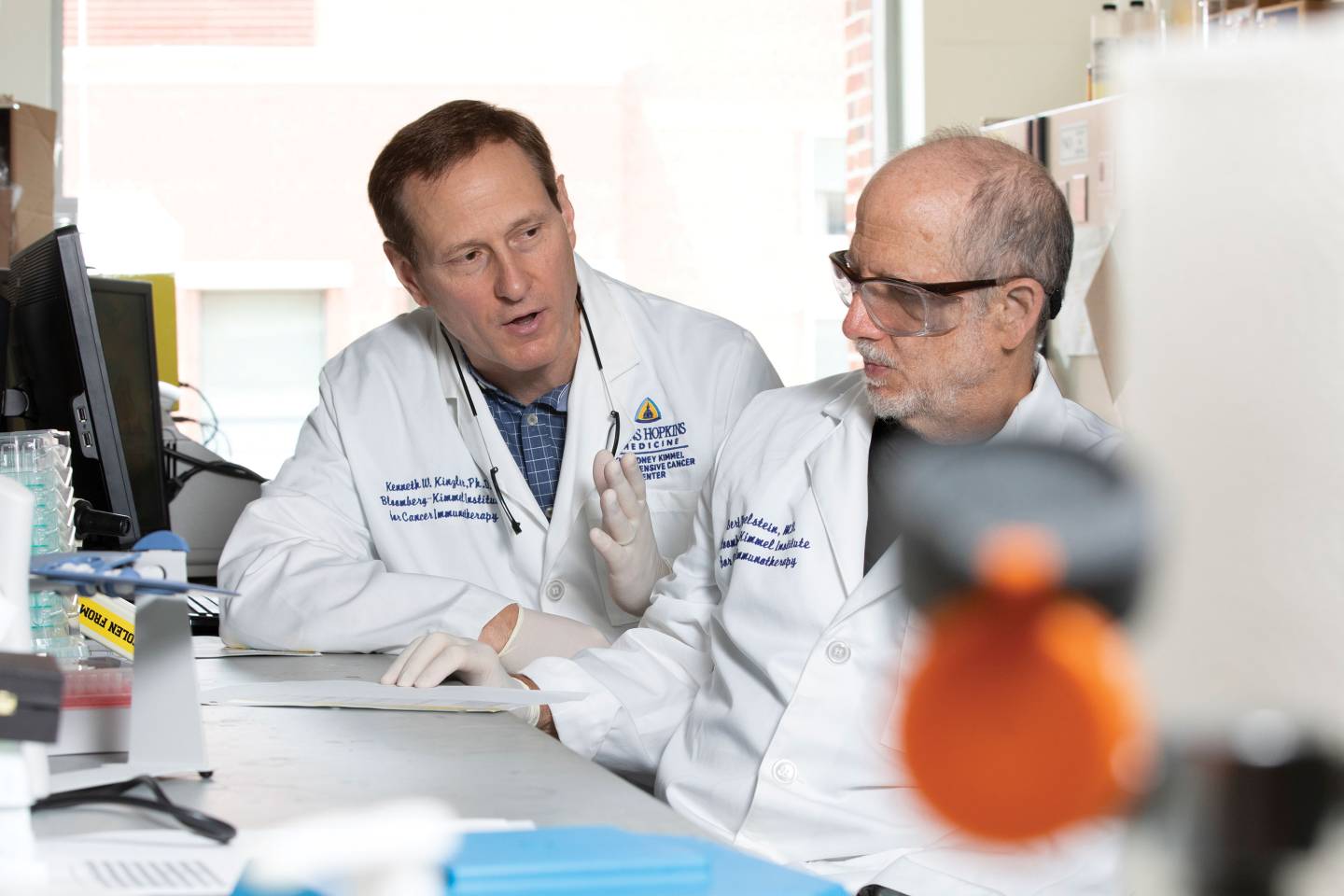
Image caption: Ken Kinzler (left) and Bert Vogelstein
Image credit: Joe Rubino
This work led to the publication of a landmark paper in 1988 in The New England Journal of Medicine concluding that colorectal cancer tumors resulted from mutations in genes that stimulate cell growth and others that suppress it. At that point, no one had identified a tumor suppressor gene. But the following year, his lab published a study showing not only that "suppressor genes"—which keep cell division in check—exist but also that a particular suppressor gene protein known as p53 is found in many types of cancer tumors. The study made the point that if a suppressor gene is altered or missing, it provides the opportunity for cells to grow out of control and form tumors.
The response to the seminal finding was wildly hopeful. One headline went so far as to describe Vogelstein as "The Man Who May Cure Cancer." Another called him "America's Hottest Scientist." A few years later, Science magazine voted p53 the "Molecule of the Year."
But the Hopkins researchers saw that comprehending cancer was more complicated than tracking down one defective gene. Although a mutated suppressor gene that could no longer control cell growth was a critical factor in the development of tumors, they knew it was only part of the puzzle.
Thus began the decadeslong endeavor to unravel the disease one genetic defect at a time, then take on the distinctly formidable task of sequencing different cancer genomes and, more recently, developing tests to detect early signs of multiple types of cancer.
Sanford Markowitz, a professor of cancer genetics at Case Western Reserve University, describes Vogelstein's contributions as "monumental" and the lab's work as "transformative."
"They've led three consecutive waves of scientific and medical revolutions," he says. "Any one of them would have made a person's career. Nobody gets lucky three times in a row."
The lab has been at the forefront of helping not just the scientific community but also the medical community understand that cancer is a genetic disease, says Jeffrey Trent, president and research director of the Translational Genomics Research Institute. "Much of its work has established new ground, and it continues to play that role," Trent says, "even when it's uncomfortable."
At the base of all that stacked-up science is the partnership Vogelstein and Kinzler began forging in the late 1980s when the former was an iconoclastic researcher and the latter a graduate student working in his lab.
They connected quickly, largely through an unusually open exchange of ideas and opinions. "We could argue about the science very early on," Kinzler remembers. "He was very tolerant about that, and it was not something you could do with other faculty members. I felt the synergy very early."
For his part, Vogelstein saw Kinzler as an exceptionally bright but practical-minded colleague who seemed a counterweight to his own bent for abstract thinking. He also was someone with whom Vogelstein could freely disagree.
"That's why I think Ken and I have been such a good team," he says. "Because, though we have enormous respect for each other, we argue whenever we can. He sometimes jokes that it's in his contract that he has to disagree with everything I say."
Those frequent debates would not just become one of the lab's distinguishing features but also a driver of its success, according to Kinzler.
Anne Marie Lennon, now director of the Division of Gastroenterology and Hepatology at the Johns Hopkins School of Medicine, remembers a particular exchange between the Ludwig Center's co-directors when she was a trainee there.
It was one of the group's weekly meetings, and she was among about a half dozen members of the team gathered around a conference table, along with Vogelstein and Kinzler. They were discussing an aspect of cancer screening. Vogelstein staked out one position; Kinzler took the opposite. And for much of the meeting they argued, sometimes vociferously, back and forth.
But just before the session was scheduled to end, the debate shifted. "Actually, I completely agree with Ken's position," said Vogelstein, to which Kinzler replied, "No, I completely agree with Bert." Then, they reversed roles, making points they had spent much of the hour rebutting.
The scene has stayed with Lennon. "I think the key point is that they believe you shouldn't say yes all the time," says Lennon. "That you shouldn't be reluctant to present an alternative way to look at a problem. And to push each other."
They came to their shared mission from different directions. Vogelstein began his career as a pediatrician. A Baltimore native, he sometimes skipped school to read books in a neighborhood library. As a 13-year-old, he was inspired by a Johns Hopkins brochure titled "The Making of a Physician." Becoming a doctor seemed a rewarding way to be true to the Jewish concept of tikkun olam, which roughly means "fix the world."
An experience during his residency in pediatrics moved Vogelstein to concentrate on cancer. He was assigned the case of a 4-year-old girl with leukemia, and her anxious parents asked him questions he couldn't begin to answer. Why did she have cancer? Had they done anything to cause it? It made him realize that if he really wanted to do something about this disease, he needed to understand it.
Kinzler's motivation was less personal. He remembers that in his teens he became aware of the "war on cancer" and early on believed that there must be a genetic aspect to the disease. As an undergraduate, he chose a toxicology program because it had a "heavy component of cancer." Kinzler said he applied to graduate school at Johns Hopkins because it had a cancer drug development program and a late application deadline. Not long afterward, he met Vogelstein, and they found they held a common belief that the key to unlocking cancer was deciphering its genetics.
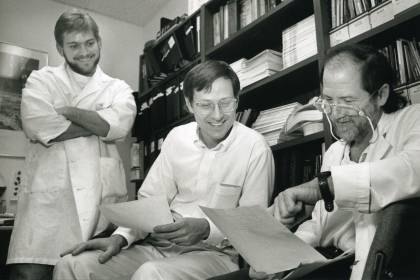
Image credit: Courtesy of Johns Hopkins Kimmel Cancer Center
In other ways, they seemed mismatched. Kinzler, a self-described tinkerer, was the kind of guy who fixed cars in high school. Vogelstein solved math problems. But the value of their complementary skills became apparent in the early days of the partnership, when the lab was intensely focused on understanding the role of mutated genes in cancer. A critical element of the lab work involved polymerase chain reactions (PCR), then a new process that allowed researchers to create a huge number of copies of DNA from a specific region of the human genome.
The technique, however, required samples to be moved between water baths of different temperatures for the necessary reactions to occur, and at the time, PCR machines were expensive and in limited supply.
"People were standing there, doing this by hand," Kinzler says. It was tedious and time-consuming, so Kinzler proposed an upgrade. Over a few days, he and his colleagues, using parts they could find around the lab or in a nearby RadioShack, built a robot. They even dressed it up with a Styrofoam head, sunglasses, and a baseball cap.
"We used an antenna rotator from a TV and a solenoid from a dishwasher. And it worked," he says. "I really think half the people in Baltimore could have made it. But we decided we were going to do it, and not just sit back and think about it."
Today, that makeshift machine is in the Smithsonian's National Museum of American History.
The lab's discoveries about the impact of alterations in specific genes moved cancer research in a bold new direction and became a turning point in the application of molecular biology to the study of human disease.
The two didn't just push the envelope, they bulldozed it. The lab, with Vogelstein and Kinzler now as co-directors, kept adjusting its focus and developing technologies to open up new avenues of study. The researchers discovered mutations that play a role in other cancers, including breast and pancreatic. They moved on to mapping the genetic sequence of about 90 different cancers, an important step in the development of personalized medicine. The lab also created digital tools that can detect trace levels of tumor DNA in blood and other body fluids, enabling gene testing for cancer to become part of mainstream medicine.
William Nelson, director of the Sidney Kimmel Comprehensive Cancer Center at Johns Hopkins, says they've managed to find a balance between going too broad and staying too locked into a narrow line of research.
"If you flitted all over the place, you'd never get anything substantial discovered," he says. "But they've done a good job of straddling the line. They focused for a time on colorectal cancer to the point where there really wasn't anything about that cancer they didn't discover or don't understand. They really led the way, and it became the model for how all cancers are studied."
Kinzler acknowledges their penchant for taking on fresh challenges. "There's been a natural progression to the research," he says. "It was all based on the desire to have an unbiased accounting of the cancer genome. But we've also always asked ourselves, 'What can we do that would be most impactful?'"
Another factor in the lab's success, Nelson says, is that early on, it embraced the notion of doing science as a team instead of a collection of researchers each looking under their own rocks. A project on developing new immunotherapy treatments, for instance, includes researchers with a range of scientific expertise, from protein structure and autoimmunity to molecular genetics and pathology.
"They've led the way in incorporating mathematical algorithms into genetics and biological research," notes Markowitz, the Case Western researcher. "You can't do that without a big team of folks who can handle the math, and folks who can handle the artificial intelligence, as well as the folks who can do the wet bench or more traditional lab work."
Max Konig, one of 30 trainees currently working in the Ludwig Center, is a good example. He's a rheumatologist by training, with a research interest in autoimmune diseases. But he says he wanted to join the lab because of its innovative research in immunotherapy. He saw it as an opportunity to gain insight into how the immune system can be used to treat autoimmune diseases.
"This has brought me into areas of science that otherwise I would not have associated myself with," Konig says. "That, in itself, is valuable. It really pushes you to the end of your comfort zone and beyond." But he also believes that working so much as a team results in better science, that it leads to more discussions that ask the right questions and identify misconceptions.
That shared focus is also appreciated from a different perspective by Shibin Zhou, an associate professor of oncology and one of Ludwig's three lead investigators.
"It's a synergy that makes it much stronger," he says. "I've come to realize that as one person, I'm limited. Working in this group, with so many different sets of talents, we can achieve much more."
From her time in the lab, Lennon remembers being struck by how evenly everyone was treated. It helps that Vogelstein and Kinzler, for all their accolades and years of experience, make a point of downplaying both.
"The youngest and most inexperienced person would be asked to comment on something first," Lennon says. "There's a medical student, and they'll be asked for their opinion, and their opinion will matter. The most senior people would go last. That's something I personally learned from them."
That's in line with two of Vogelstein's core principles: Question authority. And don't worry about getting credit.
"I taught my own kids that to have a healthy disrespect for authority is key. Certainly, in science," Vogelstein explains. "Students shouldn't be afraid to ask questions. You know, the best way to make progress is to question everybody. Question me. I'm older—much older—and more experienced, but that doesn't make me right."
Joshua Cohen, now a trainee in the Ludwig Center, recalls how timid and deferential he was at his first meeting in the lab. But that was then. "Bert has totally broken me down to the point where I now have no issue saying to him, 'That's a really bad idea. It will never work.'"
Vogelstein says that he and Kinzler try to convey to students that just because something is written doesn't make it right. "It's not the science or the experiments we're talking about. But the interpretation is often wrong," he says. "You get what becomes conventional wisdom. But if you look through the history of science, many breakthroughs have come because people questioned the past."
As for Vogelstein's attitude about taking credit, suffice it to say that he has a sign on his office wall that reads: "It's amazing how much you can accomplish if you don't care who gets the credit."
It bothers him that usually all the praise and acclaim is heaped on the heads of research labs. That, he says, doesn't reflect reality.
"Virtually all the work is done by trainees." he says. "And it's not only the hands-on work. It's the ideas. The concepts.
"You know, it's quite different in sports," he continues. "In sports, it's the players, not the management, who get the accolades, who are the heroes. I really don't understand the difference."
While they both believe lab trainees deserve more credit, Vogelstein and Kinzler feel it's also important their researchers don't take themselves too seriously. For years, when they interviewed postdoctoral candidates, they asked them to wear a cardboard crown from Burger King.
There have been no in-person Burger King crown interviews lately owing to COVID-19, but another lab tradition lives on: Some meetings still begin with someone telling a joke.
"Some of them are pretty funny," Kinzler says. "A lot of them are bad jokes. I love bad jokes."
It's about researchers maintaining a sense of humor, an important quality in a field where failure is so familiar. But it also can help boost the confidence of students with little experience speaking to groups, Vogelstein says. Not to mention that it builds a sense of collegiality.
"The joke-telling humanizes the research," says Isaac Kinde, a former Ludwig trainee who now is head of research and innovation at Thrive Earlier Detection Corp., a diagnostics firm. "When things get tough, it's important to like the people you're around," he says. "I spent years working more than 80 hours a week on things that did not work, and that gets very challenging. But if you're around the right people …"
Chetan Bettegowda, a professor of neurosurgery and one of the lab's lead investigators, sees the custom as something that connects the many Ludwig Center trainees who have gone on to excel elsewhere.
"Any time I meet with other trainees, it's an immediate bond," he says. "You're part of the Vogelstein-Kinzler lineage. And I think part of that is set by having told jokes and having opportunities to relax and enjoy each other's company."
Back in the days when Vogelstein and his Hopkins colleagues were meticulously analyzing colorectal cancer tumors, the focus was more conceptual. Their intent was to understand what was happening at a molecular level that caused a tumor to grow. But over time, the lab's mission has shifted, particularly after its researchers mapped the genomes of so many different cancers.
"Ken and I have always been interested in translational research, or research that could help people," Vogelstein says. "At first, we were doing basic research. And many people thought it was curiosity-driven research, but it wasn't. We thought we had to learn more about cancer in order to do anything about it."
Now, the Ludwig Center is at the forefront of using that knowledge to develop novel immunotherapy treatments. Last spring, researchers published several studies detailing how antibodies can be used to target hard-to-treat mutant cells in cancer tumors. The technique could be a leap forward for precision medicine by advancing the prospect of off-the-shelf immunotherapy treatments for cancers with specific mutations.
Its researchers have also made significant progress in the development of "liquid biopsies"—noninvasive blood tests that can detect a tumor at a much earlier stage.
"The majority of cancers are detected when someone goes to the doctor with some pain," says Nickolas Papadopoulos, a professor of oncology and another of Ludwig's lead investigators. "It's being reactive instead of proactive. The whole purpose of these tests is to try to detect cancers as early as possible, when the success in treating is much higher."
The blood test, called CancerSEEK, is designed to detect traces of DNA from cancer gene mutations circulating in the bloodstream. It also evaluates levels of eight cancer proteins in the system. In a clinical trial, CancerSEEK achieved a probability of 69% and above for identifying five cancer types—ovarian, liver, stomach, pancreas, and esophageal—for which no screening tests are currently available. In the trial involving about 10,000 women, the test also found 26 malignancies that hadn't been discovered by more traditional screening, such as mammograms and colonoscopies.
Licensed to Thrive Earlier Detection, CancerSEEK would ideally be used as part of routine health screenings. But before it becomes commercially available, it must be evaluated in larger clinical trials.
"They've applied the technology they built for examining all the different genetic alterations," says Nelson, the Kimmel Cancer Center director. "And they've asked, how can we get the most out of this for the field of early detection? Then, can you move therapeutically with that knowledge of defective genes in cancer and find a new way to respond to them?"
Lennon says that's one of the things that distinguishes how Vogelstein and Kinzler have steered their course.
"They don't just think six or 12 months ahead," she says, "They think, 'Where should the field be in 10 years?' And that's what truly sets them apart. They're leading the way in all the things they do."
One thing hasn't changed. For all the twists and turns their research odyssey has taken, both Vogelstein and Kinzler say they've always shared the same simple purpose that belies the complexity of their work: Do something for people with cancer.
Vogelstein concedes that there's still much he doesn't know about the disease that's defined his life's work.
"In the grand scheme of things, we know very little about cancer," he says. "But we do know something. The question is, do we know enough? I think the history of medicine is that you don't need to understand everything about a disease before you can overcome it."
He remembers when his first applications to the National Institutes of Health for grants were rejected, likely because of his unorthodox notion to study genetic mutations inside human tumors. Now, his lab has generous support from three foundations—the Ludwig Foundation, the Howard Hughes Medical Institute, and the Lustgarten Foundation—and access to technology he couldn't have imagined back then.
That has enabled the lab to make great headway in aspects of cancer research that have traditionally received less support, such as early detection. In addition to CancerSEEK, the Ludwig Center's research has led to the development of Cologuard, the first FDA-approved genetic cancer screening test.
Through it all, Vogelstein and Kinzler have remained harmonious partners and close friends. For a while, they even played in a cover band together—Vogelstein on piano, Kinzler on drums. The group was called Wild Type, a genetics term for a gene in its natural, nonmutated form.
To this day, they are committed to collaboration. "You know, everyone wants to be independent," Kinzler says, "but we point out to our students that we still run ideas by each other. We don't run off and do something unless we both agree. We think that leads to better results."
Kinzler suggests that part of the lab's secret sauce is its willingness to plunge ahead and do things instead of just pondering them. Also, it matters that he and Vogelstein still complement each other so well.
"Bert is a great closer," he says. "I love to initiate projects."
While Kinzler takes pleasure in sailing and in building projects that combine wood, metal, plastics, electronics, and software, Vogelstein doesn't have any favorite hobbies. "I have my work and my family," he says. "That's all I need." Now 72, he says he hasn't given much thought to retirement. "Should I?" he asks.
There has been a certain symmetry to his life. All the game-changing research he has fostered has occurred only a few blocks from where he was born, in Johns Hopkins Hospital.
Vogelstein has accumulated plenty of awards, including the inaugural Breakthrough Prize in Life Sciences in 2013. But he says that while it's easy for researchers to get caught up in burnishing their reputations, he and Kinzler have tried to pass on to their teams a different focus.
Take the long view.
"If your goal isn't to be promoted as much as to do something important, then a lot of stuff just doesn't matter," he says. "I think what we've found is if you do good things, everyone gets rewarded."





